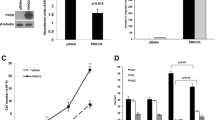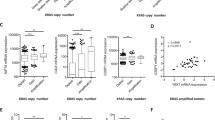Abstract
Signal transduction from tyrosine kinase receptors mediates growth regulation of breast cancer cells in part through the GTPase Ras and downstream kinases. Rsu-1 is a cDNA previously identified as an inhibitor of Ras-induced transformation. An HA-epitope tagged Rsu-1 cDNA was introduced into the MCF7 breast carcinoma cell line. Stable transfectants were selected and used for analysis of Rsu-1 expression on growth control and Ras-dependent kinase pathways. Assessment of biological activity of HA-Rsu-1 transfectants revealed that HA-Rsu-1 clones showed slower anchorage dependent growth rates than control MCF7 cell lines and a significant reduction in anchorage independent growth. Analysis of cell cycle regulatory proteins required for transit through G1 revealed that HA-Rsu-1 transfectant cell lines expressed elevated levels of p21CIP CDK inhibitor. Perturbations in signal transduction pathways which can be activated by Ras were detected in the Ha-Rsu-1 transfectants. Exposure of serum-starved cells to EGF revealed that expression of HA-Rsu-1 increased ERK-2 kinase activation, decreased activation of Jun kinase and inhibited Rho-dependent Rho-alpha kinase (ROK) activity compared to control cells. While serum starvation reduced AKT activity to undetectable levels in HA-Rsu-1 transfectants but not in control MCF7 cells, activation of AKT kinase by serum was unaffected by HA-Rsu-1 expression. Finally, the level of c-myc transcription in HA-Rsu-1 transfectants reached only 60% of the MCF7 control cell line following serum stimulation of starved cells while Fos RNA levels were similar to control cells. These results demonstrate that increased Rsu-1 expression critically altered cell cycle regulation and growth of MCF7 cells as well as signaling pathways in MCF7 cells required for malignant growth.
Similar content being viewed by others
References
Akasaka K, Tamada M, Wang F, Kariya K, Shima F, Kikuchi A, Yamamoto M, Shirouzu M, Yokoyama S, Katoaka T: Differential structural requirements for interaction of Ras protein with its distinct downstream effectors. J Biol Chem 271: 5353–5359, 1996
Albini A, Graf J, Kitten G, Kleinman H, Martin G, Veillette A, Lippman M: 17-beta-estradiol regulates and v-Ha-Ras transfection constitutively enhances MCF7 breast cancer cell interactions with the plasma membrane. Proc Natl Acad Sci 83: 8182–8186, 1986
Bacus, S, Yarden Y, Oren M, Chin DM, Lyass L, Zelnick CR, Kazarov A, Toyofuku W, Gray-Bablin J, Beerli RR, Hynes NE, Nikoforov M, Haffner R, Gudkov A, Keyomarsi K: Neu differentiation factor (Heregulin) activates a p53-dependent pathway in cancer cells. Oncogene 12: 2535–2547, 1996
Basolo F, Elliott J, Tait L, Chen XQ, Maloney T, Russo J, Pauley R, Momiki S, Caamano J, Klein-Szanto AJP, Koszaika M: Transformation of human breast epithelial cells by c-Ha-Ras oncogene. Mol Carcino 4: 25–35, 1991
Ben-Levy R, Paterson H, Marshall C, Yarden Y: A single autophosphorylation site confers oncogenicity to the Neu/ErbB-2 receptor and enables coupling to the MAP kinase pathway. EMBO J 13: 3302–3311, 1994
Blagosklonney M, Prabhu N, El-Diery W: Defects in p21WAF-1/CIP-1, Rb, and c-myc signaling in phorbol ester-resistant cancer cells. Cancer Res 57: 320–325, 1997
Bunday L, Downward J: EGF regulates p21Ras through the formation of a complex of receptor, Grb2 adaptor protein, and SOS nucleotide exchange factor. Cell 73: 611–620, 1993
Chardin P, Camonis J, Gale N, VanAelst L, Schlessinger J, Wigler M, Bar-Sagi D: Human Sos1:a guanine nucleotide exchange factor for Ras that binds to Grb2. Science 260: 1338–1343, 1993
Choi Y, Zhang L, Lee W, Park K: Genistein-induced G2/M arrest is associated with the inhibition of cyclin B1 and the induction of p21 in human breast carcinoma cells. Int J Oncol 13: 391–396, 1998
Clark G, Der C: Aberrant function of the Ras signal transduction pathway in human breast cancer. Breast Cancer Res Treat 35: 133–144, 1995
Clark G, Westwick J, Der C: p120 GAP modulates Ras activation of the Jun kinases and transformation. J Biol Chem 272: 1677–1681, 1996
Clark J, Santos-Moore A, Stevenson L, Frackelton A: Effects of tyrosine kinase inhibitors on the proliferation of human breast cancer cell lines and proteins important in the Ras signaling pathway. Int J Cancer 65: 186–191, 1996
Coso O, Chiariello M, Yu J-C, Teramoto H, Crespo P, Xu N, Miki T, Gutkind JS: The small GTP-binding proteins Rac1 and CDC42Hs regulate the activity of the JNK/SAPK Signaling pathway. Cell 81: 1137–1146, 1995
Cutler M, Bassin R, Zanoni L, Talbot N: Isolation of rsp-1, a Novel cDNA capable of suppressing v-ras. Mol Cell Biol 12: 3750–3756, 1992
Draetta G: Mammalian G1 cyclins. Current Opin Cell Biol 6: 842–846, 1994
Facchini L, Penn L: The molecular role of myc in growth and transformation: recent discoveries lead to new insights. Faseb J 12: 633–651, 1998
Franke T, Kaplan D, Cantley L. Downstream AKTion blocks apoptosis. Cell 88: 435–437, 1997
Gorospe M, Shack S, Guyton K, Samid D, Holbrook N: Upregulation and functional role of p21 WAF=CIP during growth arrest of human breast carcinoma cell lines by phenyacetate. Cell Growth Differ 7: 1609–1615, 1996
Hill C, Wynne J, Treisman R: The Rho family GTPases RhoA, Rac1, and CDC42Hs regulate transcriptional activation by SRF. Cell 81: 1159–1170, 1995
Janes P, Daly R, DeFazio A, Sutherland R: Activation of the Ras signaling pathway in human breast cancer cells overexpressing erbB-2. Oncogene 9: 3601–3608, 1994
Jones J, Cui X-S, Medina D, Donehower L: Heterozygosity of p21WAF/CIP1 enhances tumor cell proliferation and cyclin Dassociated kinase activity in a murine mammary cancer model. Cell Growth Differ 10: 213–221, 1999
Khosravi-Far R, Solski P, Clark G, Kinch M, Der C: Activation of Rac1, RhoA, and mitogen activated protein kinases is required for Ras tranformation. Mol Cell Biol 15: 6443–6453, 1995
Khosravi-Far R, White M, Westwick J, Solski P, Chrzanowska-Wodnicka M, VanAelst L, Wigler M, Der C: Oncogenic Ras activation of Raf/mitogen-activated protein kinase-independent pathways is sufficient to cause tumorigenic transformation. Mol Cell Biol 16: 3923–3933, 1996
LaBaer J, Garrett M, Stevenson L, Slingerland J, Sandhu C, Chou H, Fattaey A, Harlow E: New functional activities for the p21 family of CDK inhibitors. Genes Develop 11: 847–862, 1997
Lebowitz P, Davide J, Prendergast G: Evidence that farnesyltransferase inhibitors suppress Ras transformation by interfering with Rho activity. Mol Cell Biol 15: 6613–6622, 1995
Leung T, et al.: A novel serine/threonine kinase binding the Ras-related RhoA GTPase which translocates the kinase to peripheral membranes. J Biol Chem 270: 29051–29054, 1995
Levi A, Eldridge J, Paterson B: Molecular cloning of a gene sequence regulated by nerve growth factor. Science 238: 393–397, 1985
Lowenstein EJ, Daly RJ, Batzer AG, Li W, Margolis B, Lammers R, Ulrich A, Skolnik EY, Bar-Sagi D, Schlessinger J: The SH2 and SH3 domain-containing protein GRB2 links receptor tyrosine kinases to ras signaling. Cell 70: 413–442, 1992
Marcu K, Bossone S: Myc function and regulation. Ann Rev Biochem 61: 809–860, 1992
Masuelli L, Cutler M: Increased expression of the Ras suppressor, Rsu-1, enhances Erk-2 activation and ihnibits Jun kinase activation. Mol Cell Biol 16: 5466–5476, 1996
Masuelli L, Ettenberg S, Vasaturo F, Vestergaard-Sykes K, Cutler M: The Ras suppressor, Rsu-1, enhances NGF-induced differentiation of PC12 cells by induction of p21CIP. Cell Growth Differ 10: 555–564, 1999
Minden A, Lin A, Claret F-X, Abo A, Karin M: Selective activation of the JNK signaling cascade and c-Jun transcriptional activity by the small GTPases Rac and Rho. Cell 81: 1147–1157, 1995
Mitchell K, El-Deiry W: Overexpression of c-myc inhibits p21WAF-1/CIP-1 expression and induces S-phase entry in TPA-sensitive human cancer cells. Cell Growth Differ 10: 223–230, 1999
Oldham S, Clark G, Gangarosa L, Coffey R Jr, Der C: Activation of the Raf-1/MAP kinase cascade is not sufficient for Ras transformation of RIE-1 epithelial cells. Proc Natl Acad Sci 93: 6924–6928, 1996
Olson M, Ashworth A, Hall A: An essential role for Rho, Rac, and cdc42 GTPases in cell cycle progression through G1. Science 269: 1270–1272, 1995
Olson M, Peterson H, Marshall C: Signals from Ras and Rho GTPases interact to regulate expression of p21 WAF=CIP. Nature 394: 295–299, 1998
Prendergast G, Khosravi-Far R, Solski P, Kurzawa H, Lebowitz P, Der C: Critical role of Rho in cell transformation by oncogenic Ras. Oncogene 10: 2289–2296, 1995
Qui RG, Chen J, Kirn D, McCormick F, Symons M: An essential role for Rac in Ras transformation. Nature 374: 457–459, 1995
Rosfjord E, Maemura M, Johnson M, Torri J, Akiyama S, Woods V, Dickson R: Activation of protein kinase C by phorbal esters modulates a2b1 integrin onMCF7 breast cancer cells. Exp Cell Res 248: 260–271, 1999
Steeg P, Zhou Q: Cyclins and breast cancer. Breast Cancer Res Treat 52: 17–28, 1998
Sukamar S, Carney W, Barbacid M: Independent molecular pathways in initiation and loss of hormone responsiveness in breast carcinomas. Science 240: 524–526, 1988
Weaver V, Peterson O, Wang F, Larabell C, Briand P, Damsky C, Bissell M: Reversion of the malignant phenotype of human breast cells in three-dimensional culture and in vivo by integrin-bloocking antibodies. J Cell Biol 137: 231–245, 1997
White M, Nicollette C, Minden A, Polverino A, VanAelst L, Karin M, Wigler M: Multiple Ras functions can contribute to mammalian cell transformation. Cell 80: 533–541, 1995
Yu D, Jing T, Liu B, Yao J, Tan M, McDonnell T, Hung M: Overexpression of ErbB2 blocks Taxol-induced apoptosis by upregulation of p21CIP which inhibits p34cdc2 kinase. Mol Cell 2: 581–591, 1998
Zi X, Feyes D, Agarwal R: Anticarcinogenic effect of the favonoid anti-oxidant, sillymarin, in human breast cancer cells MDA-MB468: induction of G1 arrest through an increase in CIP1/p21 concommitant with a decrease in kinase activity of cyclin dependent kinases and associated cyclins. Clin Cancer Res 4: 1055–1064, 1998
Rights and permissions
About this article
Cite this article
Vasaturo, F., Dougherty, G. & Cutler, M. Ectopic expression of Rsu-1 results in elevation of p21CIP and inhibits anchorage-independent growth of MCF7 breast cancer cells. Breast Cancer Res Treat 61, 69–78 (2000). https://doi.org/10.1023/A:1006462323260
Issue Date:
DOI: https://doi.org/10.1023/A:1006462323260




